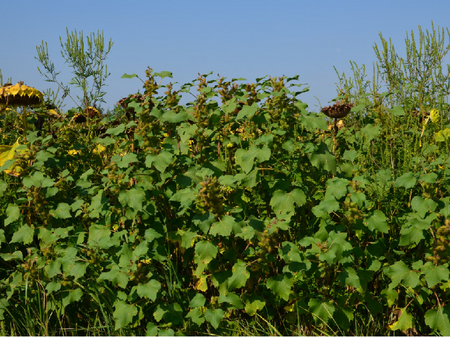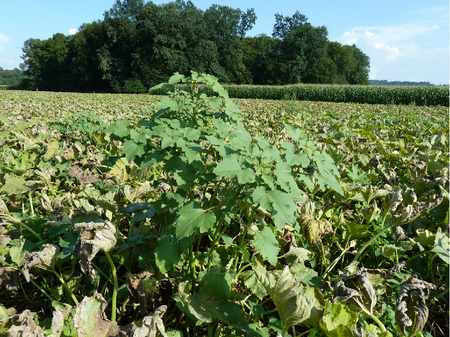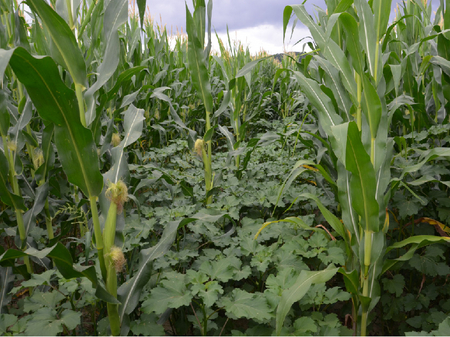Common cocklebur
Xanthium strumarium agg.
Profile
Common burdock is an annual plant of the composite family. It is an important weed in many summer crops. The species is very rich in form and occurs in Central Europe with individual clades (or subspecies) that are probably native, while other clades are classified as naturalized (native to North America).
Appearance
The cotyledons are stalked, narrowed at both ends, acuminate and pinnately lobed. The leaves are alternate, also stalked and slightly lobed. The leaf base is wedge- to heart-shaped, depending on development. On the branches of the shoots there are often dotted or dash-like drawings, some clans are without or only with indistinct drawings. Flowering time is usually in August, shortly after which the roundish-elongated fruit heads are formed, which are covered with sheathing spines. Depending on the clan, only a few to all of these spines have different hooked curvatures. The number of heads formed per plant varies greatly (about 80-400) depending on the size and degree of branching of the plant and the prevailing site conditions.
Distribution
Occurrences of common burdock in agriculture have been known from the Pannonian since the 1970s. In the early 1990s, occurrences were described in maize near Bruck an der Leitha on heavy and moist soils. Currently, in addition to occurrences in Burgenland and eastern Lower Austria, there are also larger populations in Styria in the districts of Leibnitz and southeastern Styria. Particularly affected by common burdock are root crops such as corn, soybean, oil pumpkin and sunflower.
Spread
The burdock-like fruit heads are adapted to animal dispersal (these also adhere to clothing and shoes!). In addition, the fruit heads are buoyant (up to 30 days) and can also be spread by tillage and harvesting operations in the field and over longer distances. Spread of the fruit heads via soil material (excavation) is also possible.
Economic importance
Common burdock is a competitive weed. The species is able to adapt very plastically in height and branching to its competitors and site conditions. The height ranges from 50 to 150 cm and therefore the common lard burdock can overgrow and suppress the cultivated plants. Even a few xanthium plants per square meter can reduce yield. Competition trials have shown that yield loss at 5 plants/m2 was 62% in corn and 56% in sunflower, with competition occurring throughout the growing season.



Prevention and control
- Individual plants or smaller populations should be pulled out before flowering or seed formation.
- In corn, triketones or triketone-containing herbicide combinations, among others, work well against common limpet, while in soybean the active ingredient imazamox provides control (see for other active ingredients and crops: List of plant protection products approved in Austria).
Last updated: 11.12.2025
automatically translated